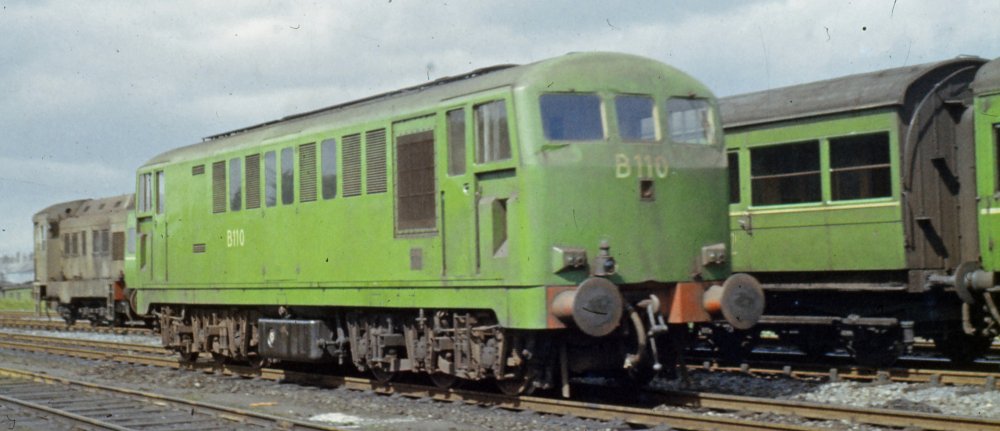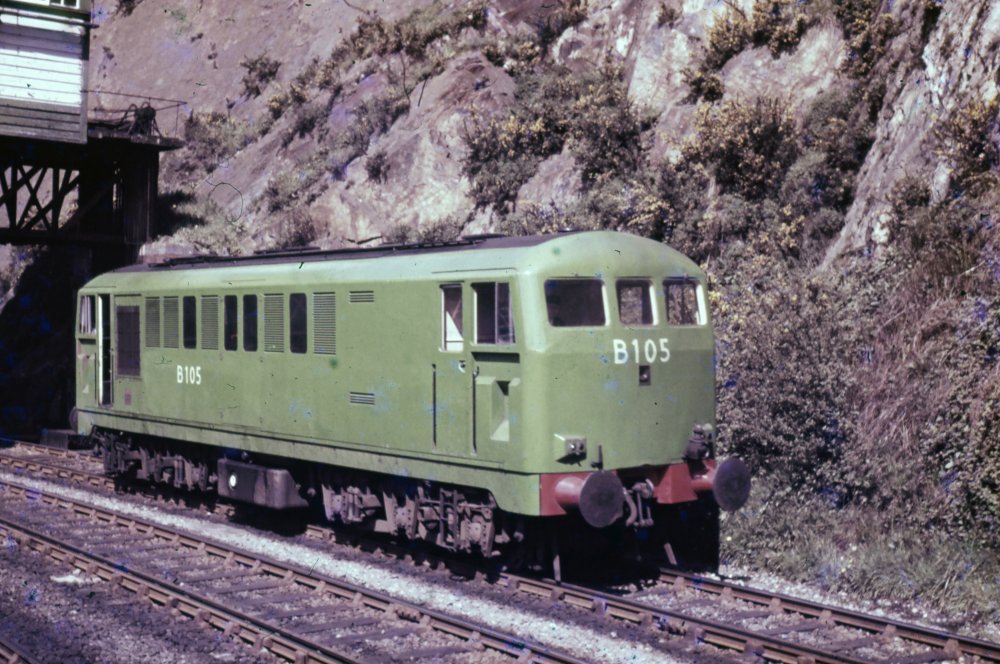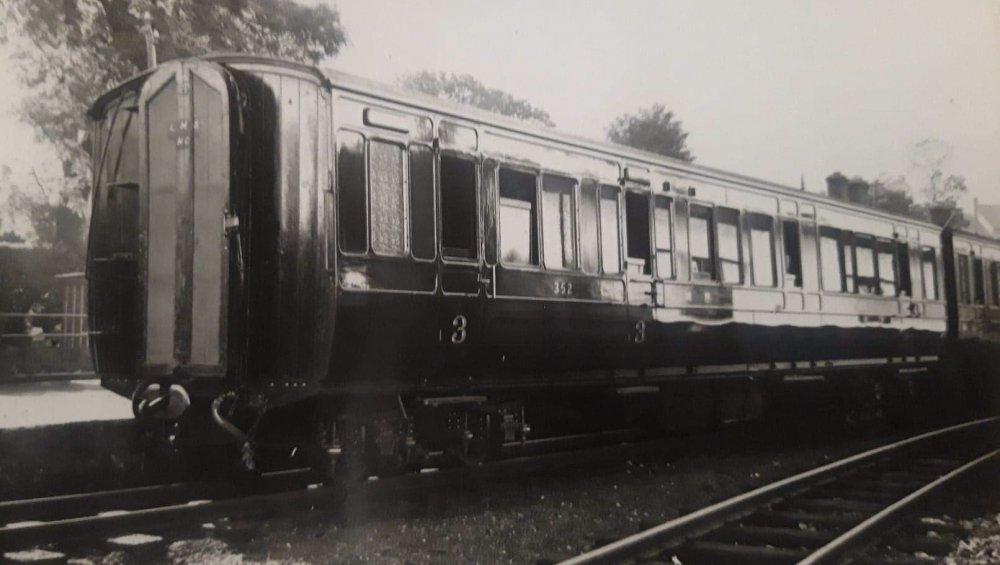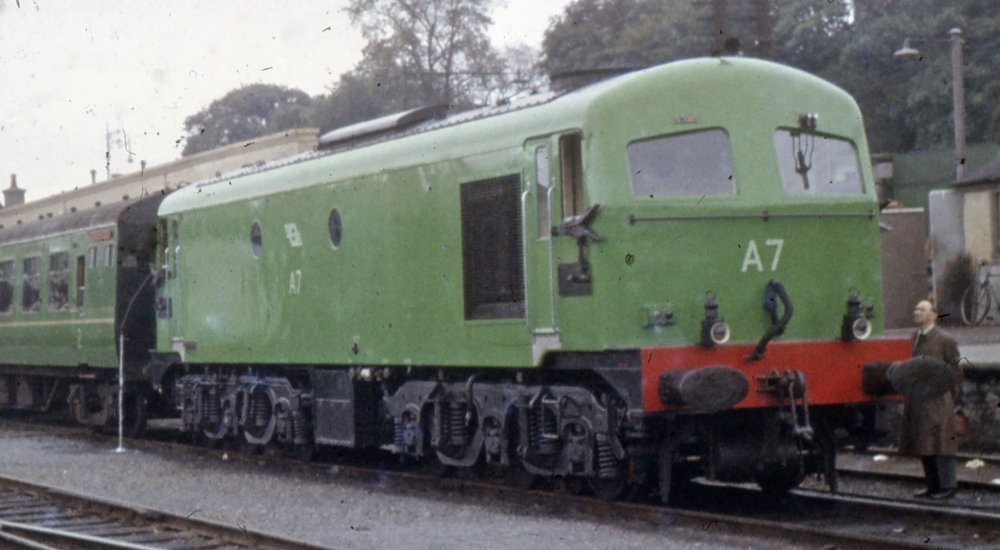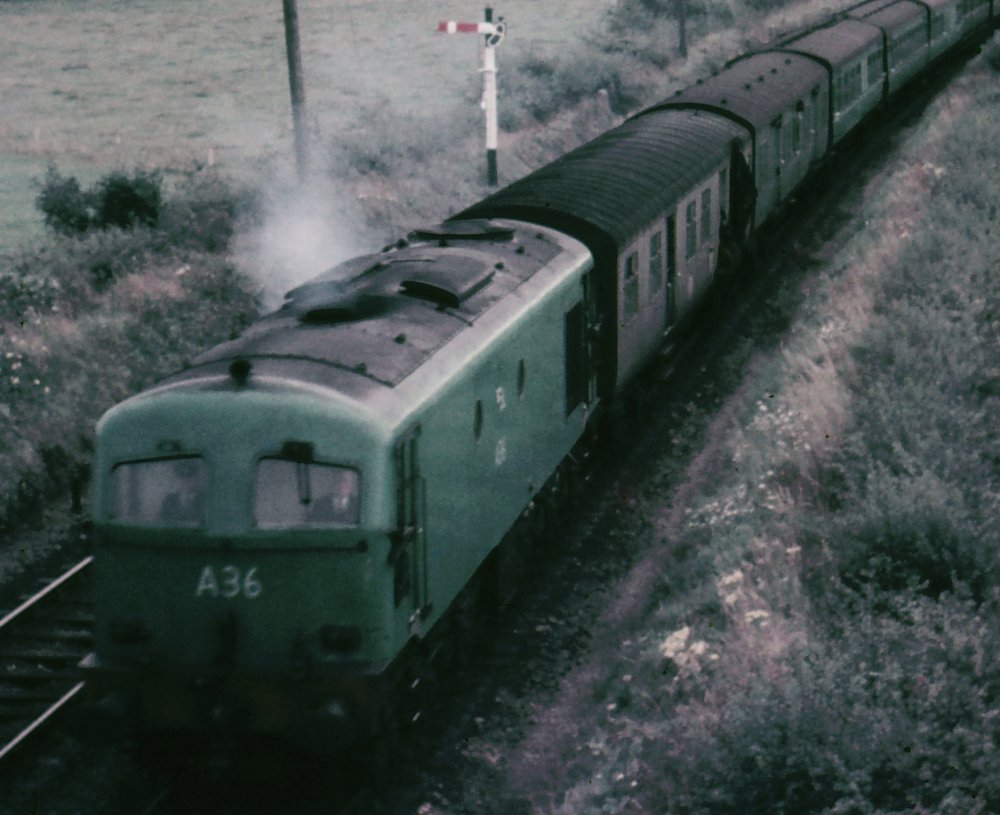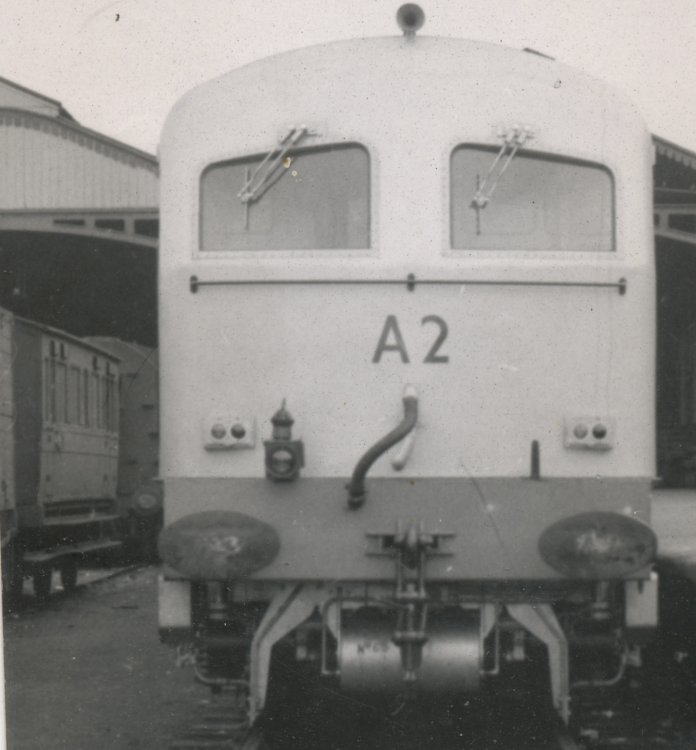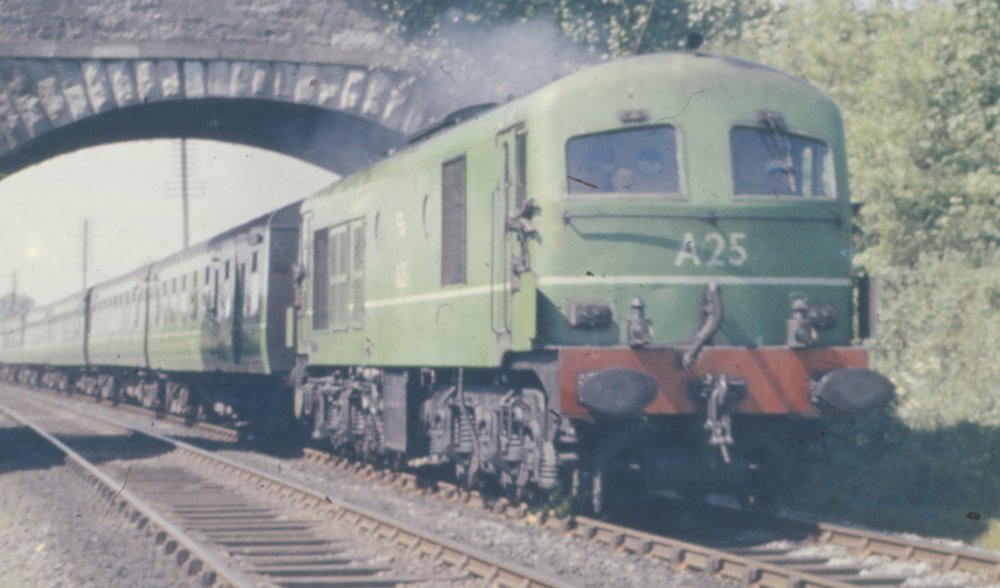-
Posts
15,923 -
Joined
-
Last visited
-
Days Won
394
Content Type
Profiles
Forums
Events
Gallery
Blogs
Community Map
Everything posted by jhb171achill
-
That shorter wheelbase type of van was almost standard prior to 1910 or so, and thus many examples lasted until the “H” vans were being produced at a serious rate of knots in the early 1960s. The West Cork system had loads of very old vans until closure in 1961.
-
Old GSR stuff such as Bredins - and much earlier (GSWR) all-wooden stock, with old double footboards, even a few non-corridor ones, were used on Dublin and Cork local services until 1974; even longer in the north, with the very last GNR and NCC coaches (now converted to railcar intermediates), in use until 1980 / 81.
-
Running your IRM A class with what stock
jhb171achill replied to DJ Dangerous's topic in General Chat
Exactly! I always think 70ft coaches look downright peculiar on 2ft or 3ft radius curves. Behind a “C”, two six-wheelers, three goods vans and a guard’s van is more than adequate, and many of the wooden bogies seen behind them, or the A or B101 class were 50ft or even 48ft. -
Running your IRM A class with what stock
jhb171achill replied to DJ Dangerous's topic in General Chat
More realistic rendition of post-1955 green. In background, a "silver" "E" on the left, and on the right a wooden GSWR bogie and what I think is the end of a Bredin. -
Yes, black bogies (with green or blue bits, things, and oddball Lego bricks amongst them) were only seen from the early to mid 2010s onwards - on anything at all.... Prior to that, brown.
-
Got a nice package today.... IMG_8204.MOV
-
Running your IRM A class with what stock
jhb171achill replied to DJ Dangerous's topic in General Chat
-
-
Irish Footbridge - Expression of Interest
jhb171achill replied to RobertRoche's topic in Irish Models
RTR bogie coach needed next! Common until the late 1960s, still about until the mid 70s! -
Running your IRM A class with what stock
jhb171achill replied to DJ Dangerous's topic in General Chat
Yes, agreed regarding RTR passenger coach! Offered in "silver-muck", green and black'n'tan..... What did they wash them with? It would be tempting to say buckets of mud! yes, yard brushes and water, mostly... I'm not sure when the first carriage washing plants were installed, but I don't think they were to be seen 1955-60........ -
Only a few years old then, and possibly with lining too, as I think they were fully lined on delivery. Not later.
-
At the bottom of this image, from Headhunters Railway Museum in Enniskillen, you see actual NCC lettering on actual NCC maroon paint. So that's the carriage colour, and that's the lettering style and colour. Often, the gold got faded to a wishy-washy creamy colour, and at the same time the shading was worn off. The NCC tended not to put lining on much secondary stock, narrow gauge included, and often no LMS crest either. Certainly in later years, the Ballycastle stock had neither lining nor crests. The above collection is worth looking at - many of the board backgrounds are in actual railway company paint, including the Dublin & Blessington; almost without doubt the only surviving example of their colour of green. Ditto the BCDR, UTA, Clogher Valley and T & DR (the huge garter on the left above the Donegal one). Gavin, regarding the lettering of the gangway COVERS, this looks to me as if it was handpainted on; thus pale yellow.
-
Running your IRM A class with what stock
jhb171achill replied to DJ Dangerous's topic in General Chat
You’ll also note the usual eclectic mix: on the left, an equally newish Park Royal, to the right an elderly GSWR coach, by then some fifty years old. -
Running your IRM A class with what stock
jhb171achill replied to DJ Dangerous's topic in General Chat
A “silver” laminate, a short-lived idea in the late 60s. And THIS is a cleanish one. The entire chassis, ends and roof are caked in a mix of general grime, brake dust and drizzle, and the only reason the sides aren’t is carriage washes. The odd one survived like this until about 1965, going directly to black’n’tan. Most were repainted green after a short time. -
Nocturnal meanderings..... LONGFORD, Summer 1974. Down Direction 0016 Down Night mail from Mullingar (Connection from down Galway night mail) 0121 North Wall - Sligo goods (loose coupled) (Tuesday to Saturday) 0305 Mullingar - Sligo goods (Monday to Friday) 0635 Mullingar - Longford local goods (Tuesday to Friday; stopped only at Mostrim). 1107 Down day mail / Passenger Up Direction 2211 Sligo - Mullingar goods (Monday - Friday) 2232 Sligo - Mullingar Mail (usually had an old Bredin brake on it for nominal passenger accommodation; I travelled in it once). 0020 Sligo - Dublin Empty Fertiliser path. (Opposite direction was during daytime) 0312 Sligo - dublin goods (Tuesday - Saturday) 0750 Longford - Mullingar light engine 0910 Sligo - Dublin passenger My own early "sounds" were loco horns heard at Westland Row / Lansdowne Road, and GNR steam whistles at Knockmore Junction.......
-
They're out spotting the Lilt cans that run up and down the line! If they want a J15 and six-wheel coaches, they might have to wait a bit longer......
-
Running your IRM A class with what stock
jhb171achill replied to DJ Dangerous's topic in General Chat
A36 rattles and coughs along the main line somewhere with a mail train. Reasonably new CIE TPO still in silver (yes, INCLUDING that filthy roof AND ends!), followed by a GSR bogie mail van, as far as I can make out, and Bredins and laminates. I think I saw another black and white pic of this train - if it’s the same one, a wooden bogie and several tin vans took up the rear. -
Running your IRM A class with what stock
jhb171achill replied to DJ Dangerous's topic in General Chat
I've identified that six-wheeler I posted earlier. Obviously of GSWR parentage, it is no. 601, one of a pair of 3rd class saloons built in 1896, and withdrawn in 1957. The other was withdrawn in early 1955, just before the "A" class entered traffic, apparently. It had a toilet, which makes me think it was probably originally a first, but my GSWR notes do not confirm this. Internally it had two 18-seat compartments, each with a bench seat along the end, and side benches (note the window layout).They were seperated by a vestibule, on one side of which was the toilet, a wash hand basin on the other. There were all manner of oddities like this well into the 1960s, though only of bogie variety after March 1963, when the last passenger-carrying six-wheelers in traffic were withdrawn in Cork, boy. If anyone buys the Hattons six-wheelers, note that while most British six-wheelers seem to have only one footstep, two were fitted to almost every single Irish six-wheeler, on all company's lines. -
Ghost trains.............. whooo whooooo Delving into the Catacombs, aka the most disorganised study even I have ever had, in 1977 we have NORTHBOUND (passing times at Howth Junction): 2133 Limerick - Kingscourt Empty gypsum 2248 North Wall - Platin Empty cement 0023 Cabra - Platin empty cement 0103 Tara empties 0238 Path for North Wall - Platin empty cement 0337 Connolly - Dundalk Newspaper train 0437 North Wall - Belfast Liner 0607 Connolly - Belfast Mail train 0821 Enterprise SOUTHBOUND 2216 Belfast - Dublin liner (left Belfast 1445, had 3 hour layover in Dundalk) 2323 Dundalk - Dublin Mail (Monday - Friday) 0002 Platin - Foynes empty Oil 0048 Path - Platin to EITHER Sligo or Wexford cement 0231 Kingscourt - limerick gypsum Tuesday & Thursday 0332 Platin - Midlands bagged cement path 0421 Dundalk (Barrack St) - North Wall Liner (Tuesday & Saturday) 0529 Tara Mines to Alexandra Road 0552 Platin - North Wall cement 0611 Platin - Cabra Bulk Cement 0930 Platin - Cabra Bulk Cement 1007 Enterprise This is the NOCTURNAL stuff - you should see what else passed in daylight! Fast forward to 2021, and we've three Taras in daytime, unphotogenic due to the graffiti scribblings of the mouth-breathers of society, and various brightly coloured tubes with people in them. Since goods trains are all but a thing of the past, and railways don't seem to have "passengers" any more, are these silver or green tubes "customer trains"? Going back to nocturnal stuff, if you examine the Cork line in those days, there are multiples of what's above. Living close to the railway line near Kildare, for example, would have you kept awake by some twenty train movements per night, none passenger obviously. Even the Limerick - Claremorris line, with not a passenger train to its name day or night, had up to seven trains a day, though 4 of these only ran if required. And almost all was "Supertrain"-liveried....... I think that this was the year when the very last black'n'tan loco was repainted..... Foynes had four regular trains per day, with EIGHT extra paths if required; thus it was theoretically possible for 12 trains a day on that line. The so-called "Runs of Goods" from Cork to North Esk went on all day long. Cherryville Junction - Waterford - Ballinacourty had twelve freight movements per day in each direction, from the through goods to the dolomite and other short workings. And today we get flustered over an 071 trailing a single standard bogie wagon with some yellow thing on it!
-
Running your IRM A class with what stock
jhb171achill replied to DJ Dangerous's topic in General Chat
Obviously when quite new, 1955. But look to the left; an 1890s GSWR 6-wheeled first class saloon, possibly now downgraded, with a much newer bogie behind it. Such was the contrast readily and regularly available. -
"........The fleet of 90 fertilizer wagons ran in that livery from when until when? I remember earlier in this thread, somebody was saying that the fertilizer wagons also ran in a different livery?......." The only liveries the ferts ever had were both initially all brown - every single detail, bogies, couplings, the lot - typical sheep-dip style, so time-honiured with most CIE (and many other Irish) wagons. Quite simply, up to 1987 they were outshopped with a CIE roundel on the second panel from the left, and after 1987 without any roundel. Numerals and other markings stayed the same, and bogies were never black. Now - disclaimer time. The above is how a newly-painted one would look. But, as you'll see on the IRM models, panels got swopped about to the Nth degree; the panel with the roundel would end up appearing anywhere, sometimes two to a side if doors were swopped, sometimes none, and often in later days not only the second from left, but ANY panel could end up being replaced by one with a logo. Many got so filthy and worn that the paint was almost all peeled off one panel or more (and the one beside it painted quite new!). Brake dust covering and weathering could make the logo or number look brownish - IRM have cleverly produced one variant with a badly weathered "roundel" but pristine white number! Nice move..... So, two liveries, but CIE logos all over the place in practice due to door-swopping.
-
Yes, it was - sorry, that’s the one I thought you meant. I missed the word “brickworks”!
-
Yes, this was a siding off a short length of the erstwhile Athy - Ballylinan / Deerpark Collieries line, which never had a passenger service, only being built by the British government in the 1910s.
-
Running your IRM A class with what stock
jhb171achill replied to DJ Dangerous's topic in General Chat
Out on the main line, A25. The photographer seems to have either followed this train, or been on it, yet in a position to take a shot like this en route. in typical style, the first three carriages are of three different types.....
.png.c363cdf5c3fb7955cd92a55eb6dbbae0.png)



